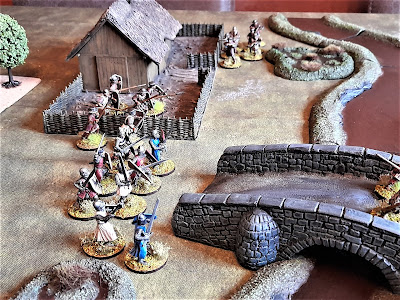Now that I have enough figures to play an assortment of Knyght, Pyke and Sworde encounters, the focus in the painting shop has switched back to Clash of Spears. I really need to play a lot more Clash, as my previous outings have resulted in all sorts of disasters. Worst of my crimes include missing the fatigue effect of actions and completely forgetting to use the wide array of traits that are assigned to the various troop types. I would have avoided the destruction of my Syracusan Peltasts, when they were attacked by Iberian Scutarii, if I had applied their Skirmish Specialist trait, which allows them a free four inch reaction move... every day is a school day in the world of Clash!
Adding another faction to my collection of Chronicles of Sicily forces, gives me the opportunity to play more games and learn a few more trait effects. You don't get a lot of Romans for 500 points in Clash of Spears, so this winter's painting list includes more Velites and Hastati, some Cretan Archers and some recently e-bay acquired Roman Cavalry.
First up in my Roman order of battle are a group of six Velites...
Figures are Victrix Republican Romans... the Velites are included in both sets of Victrix Legionaries and are beautiful figures to model and paint. They can be built as the earlier Leves, which have no shields, but I prefer this version, with shield, sword and bristling with javelins. My plans for the 900 point warband include at least one more unit of these.
Next come a group of eight Hastati...
I chose 8 figures for the Hastati as they are the backbone of the Roman warband and legionaries are traditionally organised in contubernia of 8 men. I'm not sure if this was the case at this point in the development of the Roman legion, but I like the sturdy feel of 8 of these guys on the battlefield... with heavy shield, partial armour and throwing spear, they cost 20 points a man and they have a host of traits (shield overlap, wall of spears, impulsum and drilled) that you have to master the use of.
Only just completed are a group of six Princeps...
Being more heavily armoured than the Hastati, costing an extra 5 points per man, I thought 6 of these to a unit would be enough. As things stand, I wont add any more of these when the Romans expand to a 900 point warband although, I'm planning some 500 point games against Carthage and Syracuse so the results of those might just lead to a change of plan.
The current Roman order of battle lacks any ability to hit from a distance, so I've bought some Warlord Cretan Archers to fulfil that role. I also have some Victrix cavalry to paint up, but with Princeps being Milites and Cretans and Roman Cavalry both being Rare, fielding them all would result in an Ad Hoc Warband rather than a Muster Warband, which is what I would rather have!
Either way, this is the man who will have to command them all. At 900 points, I will need to add a second leader to have enough Command Points to go around. So, this chap will be a Level 4 Leader and a, yet to be painted, second in command will be either a Level 2 or 3.

























